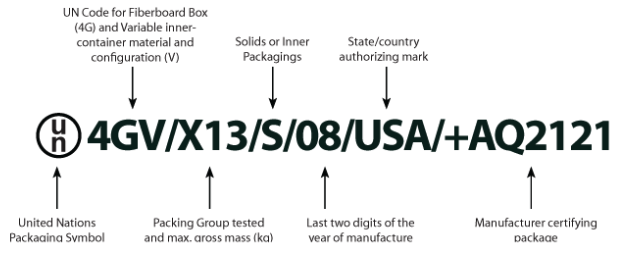Let's look at the following example of a UN specification marking:

The ultimate goal we have when packing dangerous goods is to pack it in a manner to prevent the escape of the material contained within it. This is accomplished by utilizing UN approved packaging. International agreements for the carriage of dangerous goods require packaging to be of a design-type, certified by a national competent authority. This involves testing the packaging against the appropriate UN specifications to ensure its suitability for the carriage of certain dangerous goods.
Such packaging is often referred to as “type-approved”, “UN Approved” or “UN certified” “POP” (performance oriented) and is marked in a particular way, prefixed by the UN Packaging symbol and followed by alpha numeric codes. It is not only important to select the correct UN approved packaging, but it is also important to use it as it was tested and carefully follow the closure information provided by the manufacturer.
Part of choosing the right fiberboard box or other type of outer packaging revolves around the following information:
- The UN number or proper shipping name of the dangerous goods being shipped
- The amount of dangerous goods being shipped
- The physical dimensions and weight of the inner packaging that the substance will be shipped in
When a shipper has determined the information from above, we can then examine a UN specification marking to see if the fiberboard package or other type of outer packaging is suitable for shipping the desired dangerous goods.
UN Packaging symbol: the symbol signifies that a package has been tested and has passed UN packaging performance tests. The symbol should not be applied to a package for any other purpose, especially if that package has not been tested.
UN Codes for Type of Packaging and Material of Construction: There are several different types of packagings along with several different materials in which they are constructed from. The following gives a brief overview of each:
Types of Packaging
- 1 — Drums/Pails
- 2 — Barrels
- 3 — Jerrycans
- 4 — Box
- 5 — Bag
- 6 — Composite packaging
Materials of Construction
- A — Steel
- B — Aluminum
- C — Natural wood
- D — Plywood
- F — Reconstituted wood
- G — Fiberboard
- H — Plastic material
- L — Textile
- M — Paper, multi-wall
- N — Metal (other than steel or aluminum)
- P — Glass, porcelain or stoneware (not used in these regulations)
Packing Group: Packing group assignments determine the degree of danger of a dangerous goods item, so the following outlines how to determine if your dangerous goods can go inside of a UN specification package:
- X — for packing groups I, II and III
- Y — for packing groups II and III
- Z — for packing group III
Maximum Gross Weight: For outer packagings intended for solids, this marking will indicate the maximum gross mass (weight) in kilograms at which the package has been tested for.
Year of Manufacture: This represents the last two digits of the year in which the package was manufactured.
Origin of Manufacture: This represents the country where the package was constructed.
Manufacturer Code: The last part of the UN specification marking sequence represents the code for the manufacturing plant or testing facility for the package
